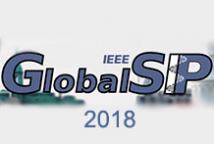
The 6th IEEE Global Conference on Signal and Information Processing (GlobalSIP) focuses on signal and information processing with an emphasis on up-and-coming signal processing themes. The conference features world-class plenary speeches, distinguished symposium talks, tutorials, exhibits, oral and poster sessions, and panels. GlobalSIP is comprised of co-located General Symposium and symposia selected based on responses to the call-for-symposia proposals.

- Read more about GlobalSIP 2018 Keynote: Tensors and Probability: An Intriguing Union (N. Sidiropoulos, N. Kargas, X. Fu)
- Log in to post comments
We reveal an interesting link between tensors and multivariate statistics. The rank of a multivariate probability tensor can be interpreted as a nonlinear measure of statistical dependence of the associated random variables. Rank equals one when the random variables are independent, and complete statistical dependence corresponds to full rank; but we show that rank as low as two can already model strong statistical dependence.
- Categories:
 110 Views
110 Views
- Read more about Dynamic Network Identification From Non-stationary Vector Autoregressive Time Series
- Log in to post comments
Learning the dynamics of complex systems features a large number of applications in data science. Graph-based modeling and inference underpins the most prominent family of approaches to learn complex dynamics due to their ability to capture the intrinsic sparsity of direct interactions in such systems. They also provide the user with interpretable graphs that unveil behavioral patterns and changes.
- Categories:
 43 Views
43 Views
- Read more about Efficient RFI detection in radio astronomy based on Compressive Statistical Sensing
- Log in to post comments
In this paper, we present an efficient method for radio frequency interference (RFI) detection based on cyclic spectrum analysis that relies on compressive statistical sensing to estimate the cyclic spectrum from sub-Nyquist data. We refer to this method as compressive statistical sensing (CSS), since we utilize the statistical autocovariance matrix from the compressed data.
- Categories:
 95 Views
95 Views
- Read more about Compressing Unstructured Mesh Data Using Spline Fits, Compressed Sensing, and Regression Methods
- Log in to post comments
Compressing unstructured mesh data from computer simulations poses several challenges that are not encountered in the compression of images or videos. Since the spatial locations of the points are not on a regular grid, as in an image, it is difficult to identify near neighbors of a point whose values can be exploited for compression.
- Categories:
 35 Views
35 Views
- Read more about TRANSMISSION DESIGN FOR A JOINT MIMO RADAR AND MU-MIMO DOWNLINK COMMUNICATION SYSTEM
- Log in to post comments
We study a cooperative transmission scheme for a joint multiple-input-multiple-output (MIMO) radar and multi-user (MU) MIMO downlink communication system, where both systems operate on the same frequency band simultaneously. Maximization of the total weighted system mutual information or sum rate is considered with the presence of an extended target and environmental clutter. An alternating optimization based iterative algorithm is proposed to find the transmit covariance matrices for both radar and communication applications.
GlobalSIP.pdf
- Categories:
 38 Views
38 Views
- Read more about SECURITY ISSUES IN SPECTRUM SHARING BETWEEN RADAR AND COMMUNICATION SYSTEMS
- Log in to post comments
To satisfy the increasing consumer demand for mobile data,
regulatory bodies have set forward to allow commercial
wireless systems to operate on spectrum bands that until
recently were reserved for military radar. Such co-existence
would require mechanisms for controlling the interference.
One such mechanism is to assign a precoder to the communication
system, designed to meet certain interference related
objectives. This paper looks into whether the implicit radar
information contained in such precoder can be exploited by
- Categories:
 40 Views
40 Views
- Read more about Security in the Internet of Things: Information Theoretic Insights
- Log in to post comments
The emerging Internet of Things (IoT) has several salient characteristics that differentiate it from existing wireless networking architectures. These include the deployment of very large numbers of (possibly) low-complexity terminals; the need for low-latency, short-packet communications (e.g., to support automation); light or no infrastructure; and primary applications of data gathering, inference and control.
- Categories:
 42 Views
42 Views
- Read more about Cryptographic Side-Channel Signaling and Authentication via Fingerprint Embedding
- Log in to post comments
We describe a general framework for designing and embedding a fingerprint at the physical layer of a wireless network to achieve authentication with enhanced security and stealth. Fingerprint embedding is a key-aided process of superimposing a low-power tag to the primary message waveform for the purpose of authenticating the transmission. The tag is uniquely created from the message and key, and successful authentication is achieved when the correct tag is detected by the receiver.
- Categories:
 51 Views
51 Views
- Read more about Self-Supervised Anomaly Detection for Narrowband SETI Presentation
- Log in to post comments
- Categories:
 21 Views
21 Views
- Read more about PATCH-AWARE AVERAGING FILTER FOR SCALING IN POINT CLOUD COMPRESSION
- Log in to post comments
With the development of augmented reality, the delivery and storage of 3D content have become an important research area. Among the proposals for point cloud compression collected by MPEG, Apple’s Test Model Category 2 (TMC2) achieves the highest quality for 3D sequences under a bitrate constraint. However, the TMC2 framework is not spatially scalable. In this paper, we add interpolation compo- nents which make TMC2 suitable for flexible resolution. We apply a patch-aware averaging filter to eliminate most outliers which result from the interpolation.
- Categories:
 41 Views
41 Views